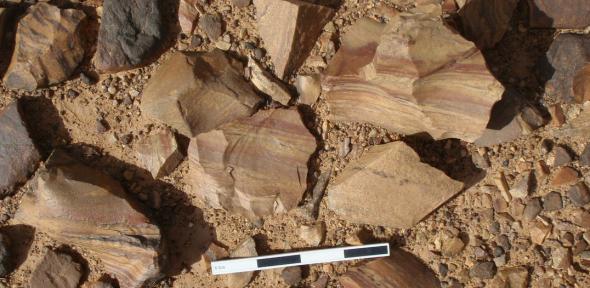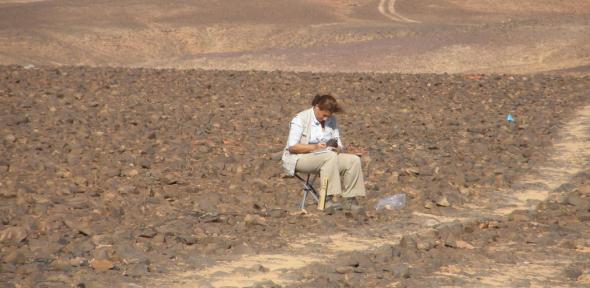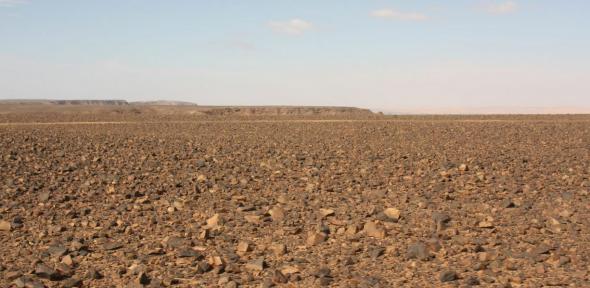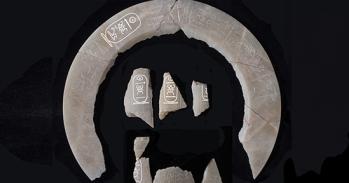
Researchers used the new survey of the Messak Settafet to estimate that enough stone tools were discarded over the course of human evolution in Africa to build more than one Great Pyramid for every square kilometre of land on the continent.
Researchers used the new survey of the Messak Settafet to estimate that enough stone tools were discarded over the course of human evolution in Africa to build more than one Great Pyramid for every square kilometre of land on the continent.
Landscapes such as these must have been magnets for hominin populations, either for ‘stone foraging trips’ or residential occupation
Robert Foley
A new intensive survey of the Messak Settafet escarpment, a massive outcrop of sandstone in the middle of the Saharan desert, has shown that stone tools occur “ubiquitously” across the entire landscape: averaging 75 artefacts per square metre, or 75 million per square kilometre.
Researchers say the vast ‘carpet’ of stone-age tools – extracted from and discarded onto the escarpment over hundreds of thousands of years – is the earliest known example of an entire landscape being modified by hominins: the group of creatures that include us and our ancestral species.
The Messak Settafet runs a total length of 350 km, with an average width of 60 km. Parts of the landscape are ‘anthropogenic’, or man-made, through build-up of tools over hundreds of thousands of years.
The research team have used this and other studies to attempt to estimate the volume of stone tools discarded over the last one million years of human evolution on the African continent alone. They say that it is the equivalent of more than one Great Pyramid of Giza per square kilometre of the entire continent (2.1 x 1014 cubic metres of rock).
“The Messak sandstone, now in the middle of the vast sand seas of Libya, would have been a high quality rock for hominins to fracture – the landscape is in effect a carpet of stone tools, most probably made in the Middle and Upper Pleistocene,” said Professor Robert Foley, from the Leverhulme Centre for Evolutionary Studies at the University of Cambridge, who conducted the research with colleague Dr Marta Mirazón Lahr.
“The term ‘anthropocene’ is now used to denote the point at which humans began to have a significant effect on the environment,” said Mirazón Lahr. “The critical time may well be the beginning of the industrial revolution about 200 years ago. Some talk of an ‘early anthropocene’ about 10,000 years ago when forests began being cleared for agriculture.
“Making stone tools, however, dates back more than two million years, and little research has been done on the impact of this activity. The Messak Settafet is the earliest demonstrated example of the scars of human activity across an entire landscape; the effects of our technology on the environment may be considerably older than previously thought,” Mirazón Lahr said. The study is published today in the journal PLOS One.
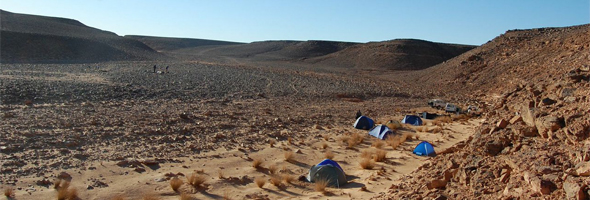
The survey, conducted in 2011, involved randomly selecting plots of one metre squared across the parts of the plateau surface. In each square, the researchers sifted through all the stones to identify the number that showed evidence of modification through hominin activity – evidence such as a ‘bulb of percussion’: a bulge or curved dent on the surface of a stone tool produced by the angular blows of hominin percussion. The average number of artefacts across all sample squares was 75.
At the simple end, large flakes of stone would have been opportunistically hacked from boulders to be used for cutting or as weapons. At the more sophisticated level, researchers found evidence that specific tools had been used to wedge into the stone in order split it.
“It is clear from the scale of activity how important stone tools were, and shows that African hominins were strongly technologically dependent,” said Foley. “Landscapes such as these must have been magnets for hominin populations, either for ‘stone foraging trips’ or residential occupation.”
The researchers say that if – as seems likely – the success of Stone Age communities depended significantly on tool technology, there would be enormous advantage to knowing, remembering and indeed controlling access to areas with a “super-abundance” of raw materials, such as the Messak Settafet.
“Hominins may well have become tethered to these areas, unable to stray too far if survival depended on access to the raw materials for tools, and forced to make other adaptations subservient to that need,” said Mirazón Lahr.
One way that the environmental impact of hominin tool excavation may have been positive for later humans is through the clusters of small quarrying pits dotted across the landscape (ranging up to 2 metres in diameter, and 50 centimetres in depth).
These pits would have retained moisture – with surface water still visible today after rains – and the small pools would have attracted game. In many of these pits, the team found ‘trapping stones’: large stones used for traps and ties for game and/or cattle during the last 10,000 years.
By combining their data with previous extensive surveys carried out across Africa, the researchers attempted to estimate roughly how much stone had been used as tools and discarded during human evolution.
Although stone tool manufacture dates back at least 2.5 million years, the researchers limited the estimate to one million years. Based on their and others research, they standardised population density (based on extant hunter-gatherers), tool volume, the number of tools used by one person in a year and the amount of resulting debris per tool.
They estimate an average density of between 0.5 and 5 million stone artefacts per square kilometre of Africa. When converted into an estimate of volume, this is the equivalent of between 42 to 84 million Great Pyramids of Giza.
Researchers say this would be the equivalent of finding between 1.3 and 2.7 Great Pyramids per square kilometre throughout Africa.
The text in this work is licensed under a Creative Commons Licence. If you use this content on your site please link back to this page. For image rights, please see the credits associated with each individual image.

